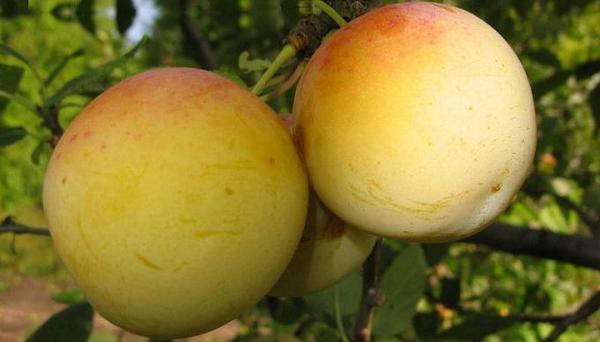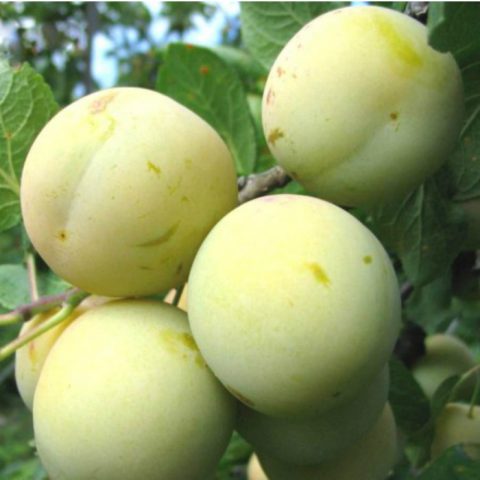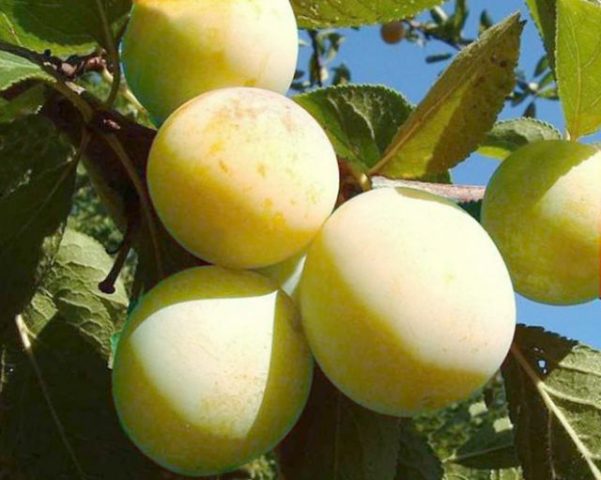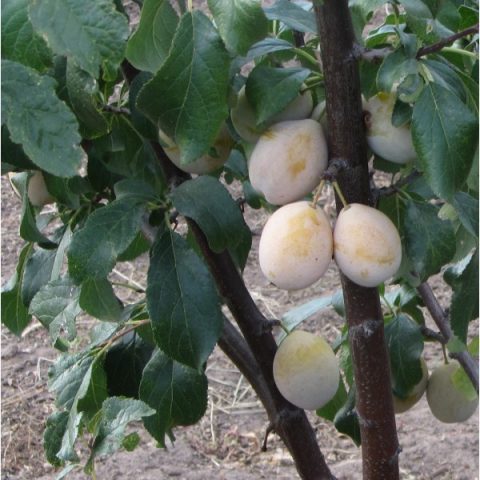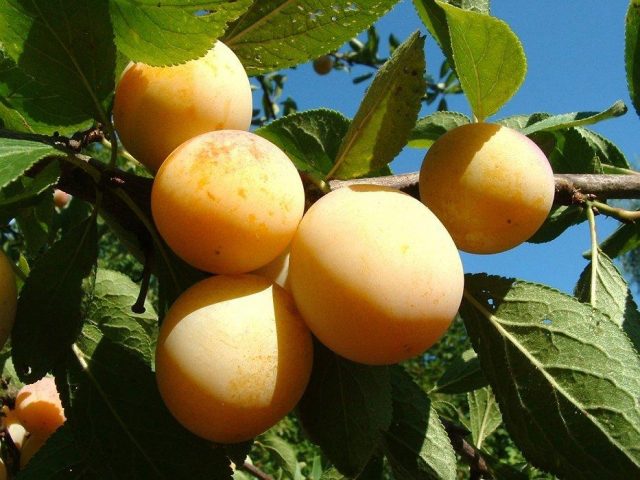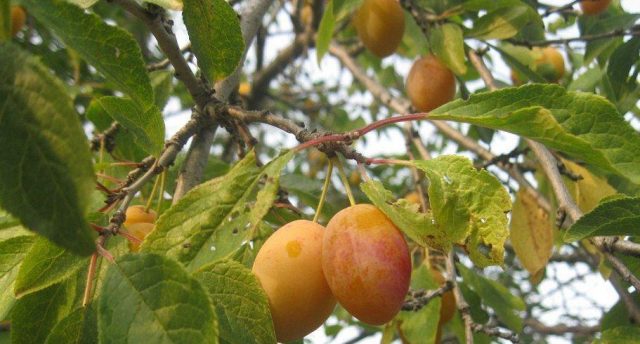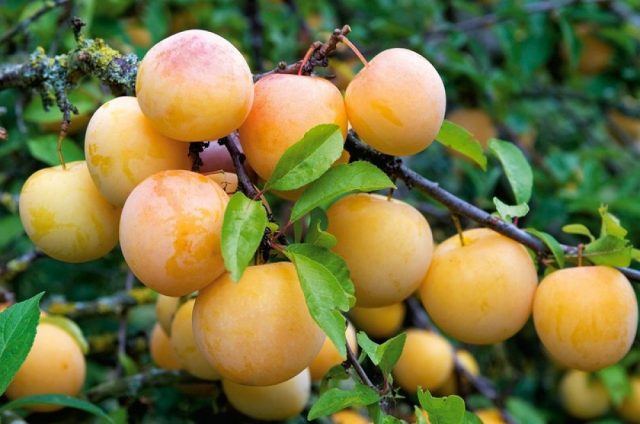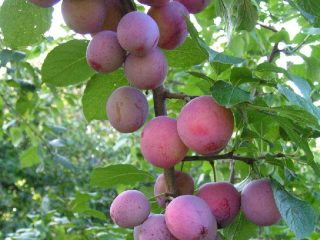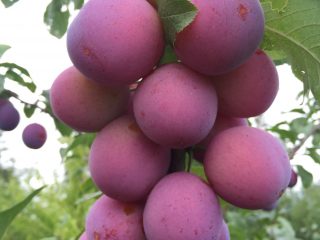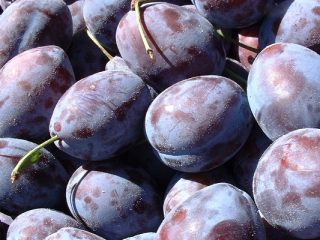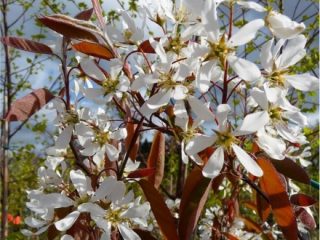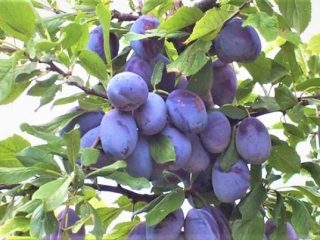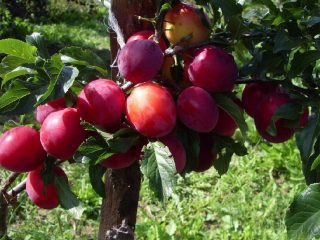Content
Yellow plum is one of the varieties of domestic plum. It is often confused with cherry plum and this is not without reason. Firstly, the domestic plum is, in fact, a hybrid of sloe and cherry plum, and secondly, many varieties of yellow plums are obtained by crossing with cherry plum.
From a botanical point of view, yellow plum refers to some subspecies of domestic plums, belonging to the group of mirabelles, renclades or Chinese plums, which have a corresponding color. Their origin can be very diverse: both hybrid crossing and artificial selection.
Description of the yellow plum tree and fruit
The height of the plant is significantly lower than that of ordinary plums. The tallest representatives of the “yellow fruits” do not exceed 7 m. The shape of the crown can be ovoid or spherical. In some low-growing varieties it has an irregular shape.
The leaves are alternate, ovoid; they have barely noticeable pubescence below and a short petiole. The leaf sizes usually range from 2-6 cm in width and 5-12 cm in length.
Up to 3 flowers can form in generative buds. The flowers are usually white or pink. Their diameter rarely exceeds 20 mm. The plant is monoecious, but self-fertility depends on the variety.
Fruit ripening, depending on the variety, occurs from July to September. The diameter of the fruit varies widely from 18 mm to 50 mm. Taste qualities, pulp structure, wateriness of the fruit and other similar characteristics can be very diverse and greatly depend on the specific variety.
The existing prejudice that the yellow color, which is a sign of kinship with cherry plum, means the sour taste of the fruit is not supported by anything.
Yellow plum varieties
The variety of domestic yellow plums is represented by several dozen varieties, which are classified mainly by ripening time.
There are other classifications based on common origin, taste, shades, etc. However, since most plums are self-sterile, for their proper pollination, varieties that have similar flowering and fruiting periods should be selected.
Types of yellow plums
Large yellow plum
Large-fruited yellow plums include varieties such as Zolotistaya large, Large-fruited Eliseeva, Jefferson, Svetlyachok, etc. This is one of the most common groups of yellow plums.
Let's consider variety description yellow plum Golden large, as a typical representative of the group with large-sized fruits. This is a medium-sized tree, about 4-5 m high, with a pyramidal crown. The size of the fruit can vary widely (40-60 g), however, under favorable conditions, such plums can produce fruits of greater weight.
The flesh is yellow and tender. The taste is sour and sad. Taste rating 4.8 points (hereinafter all ratings are given on a five-point scale). The pulp is difficult to separate from the stone.
The variety is self-fertile, but requires pollinators to improve yield: Volga Beauty or Peaceful.
Early yellow plum
Let's look at the descriptions of early ripening yellow plum varieties.
One of the earliest summer varieties of yellow plum is Honey or White Honey. The weight of the fruits of this variety can reach 50 g, but on average it is in the range of 30-35 g. Ripening occurs by mid-July to early August.
The tree rarely exceeds a height of 5 m. The crown is rounded and branched. The fruits have an almost perfect round shape with a slight waxy coating. They are quite dense and transport well. The taste rating for the quality of the fruit is 4.5 points. Disadvantages include poor separation of dense pulp from the stone.
The plant needs pollinators. Based on the timing of flowering, the varieties Vengerka Early or Renkloda Karbyshev are best suited for this purpose.
Another early ripening variety is Renklod Early. Its ripening period begins in the third ten days of July - in the first ten days of August. The tree has a height of 4-5 m, the shape of the crown is round.
The weight of the fruit is in the range of 40-50 g. The skin of the fruit is strong, but thin. The waxy coating is noticeable. The flesh of this greenweed has a greenish tint.It is dense and juicy, has a honey flavor and a strong aroma.
The variety is self-sterile and therefore requires pollinators. The best pollinator, like Medova’s, is Renklod Karbysheva.
Yellow plum varieties of medium ripening
This is one of the most common groups of yellow plums. A typical representative of which is Renklod Bely. Its ripening period occurs in the second half of August.
The plant reaches a height of 3.5-4 m. It has highly branching shoots. The crown is rounded. Fruit weight is 35-40 g. They have an excellent appearance and are well transported. The pulp is juicy and aromatic, the color is light yellow, up to yellow-white.
Usually grown by grafting, cherry plum is used as a rootstock. Self-sterile, therefore requires pollinators: Hungarian Donetskaya or Renklod Karbysheva.
The large yellow plum of the Golden Drop variety is obtained from crossing the Egg yellow plum and the green Renclod. The variety is quite old, English selection. The tree reaches a height of 5-6 m. The density of the branches is average. Ripening time is the second half of August.
The fruits weigh on average 40 g; in favorable conditions, especially large specimens weighing 55-60 g can be found. The pulp is golden in color, the stone does not separate freely. The variety is self-sterile. Pollinators can be: Renklod Altana, Renklod Zeleny.
Late plum varieties
Such varieties ripen mainly in the second half of August and the first ten days of September. A typical representative of this group is Yellow Afaska. The hybrid was bred in Bulgaria based on local yellow plum and cherry plum. Cherry plum is also considered the best rootstock for grafting. Ripening occurs in early September.
Tree up to 4 m high with strongly branching lateral branches.The fruits are large, 50-70g, and have a slightly elongated shape. The waxy coating is thin, but clearly visible due to its bluish-gray color.
They have a small bone that is easily separated from the pulp. The pulp itself is very dense, but sweet and tasty.
The variety is considered self-fertile, so theoretically it does not require pollinators. It is highly resistant to fungal diseases.
Another representative of late varieties is Egg. This is one of the oldest varieties, bred more than 300 years ago. The variety ripens in September.
The tree is relatively tall - up to 6.5 m. The crown has a wide, rounded shape. The density of the branches is average. The amount of leaf mass is small.
The fruits are medium size, weighing 25-30 g. The pulp is yellow, fibrous, of medium density. It practically does not separate from the bone. The variety requires prompt processing after collection, since it is not stored for a long time. It is used to make jams and jams. Does not require pollinators.
Like all “old” varieties, it is susceptible to a large number of diseases, mainly fungi.
Yellow plum pear-shaped
A typical representative of pear-shaped yellow varieties is Natasha, obtained by crossing the Ochakovskaya Yellow and the Hungarian Azhanskaya.
The tree is 4.5-5 m high, the crown shape is pyramidal. Requires virtually no pruning.
The variety is a mid-season variety, ripening occurs in mid-August. The fruits are medium in size, weighing 35-40 g. The shape of the fruit is characteristic elongated pear-shaped. The waxy coating is clearly visible and palpable. There are many dots on the fruits.
The pulp is yellow-orange, juicy and grainy. The taste is sweet and sour.
The variety is self-fertile and requires pollinators. The Edinburgh and German Reward varieties are best suited for this purpose.
Yellow sweet plum
Among yellow plums, the mid-late Jefferson variety is considered the sweetest. This variety is specially used for making juices and jams. This is explained by the high concentration of sugar (up to 17%) and low acid content (less than 8%). The tasting score of the variety is 4.8 points.
The tree has a height of 4 m, its crown is oval-elongated, with a diameter of 3-3.5 m. The fruits are large, up to 60 g. Yellow-green pulp, slightly separated from the stone. It has a delicate and soft consistency. Despite the softness of the fruit, it has high transportability.
The variety is self-sterile. Requires pollinators: Early Blue, Renclaude de Beauvais.
Low growing yellow plum
Small yellow plum trees have an undeniable advantage: they are easy to harvest and easier to care for.
A typical representative of low-growing trees of this type is Bolkhovchanka. The height of this variety rarely exceeds 2.5 m. Typically, the height of the trees is 1.9-2.2 m. The crown has a spherical shape.
The weight of the fruit is about 30-40 g. They are ovoid in shape. The pulp is sweet and sour, yellowish, easily separated from the stone.
The variety is self-sterile. Pollinators: Record and Renklod Kolkhozny.
Planting and caring for yellow plum
Let's look at how to plant a yellow plum and care for it. In terms of care, the plum tree is a tree with moderate labor intensity: maintaining it in good condition is more difficult than an apple tree, but easier than an apricot.
The lifespan of plums can reach up to 30 years. Maximum fruiting occurs between 5-20 years of life. The early years of the seedling's life will be especially difficult, however, when the first two harvests are taken from it, plant care will be reduced to a minimum.
Selecting a location and preparing the soil for planting
The solution to the question of how to properly plant a yellow plum should begin with choosing a planting site. The tree prefers sunny places, protected from northern winds. The soil can be any, but light loam with neutral acidity is preferred.
Plum is one of the few plants that loves constant moistening of the root system, so the groundwater level is not critical for it.
How to plant yellow plum
Planting yellow plum can be done both in spring and autumn. The planting algorithm is approximately the same, however, depending on whether the planting was done at the beginning or end of the season, there are slight differences.
Preparation of the hole for planting a yellow plum seedling should take place 15-20 days before planting it in the ground. The depth of the pit and its diameter range from 0.5 to 0.6 m. 15 cm of humus, compost or topsoil is placed at the bottom.
In addition, it is recommended to add mineral fertilizers to the pit and water it. Composition of mineral fertilizers:
- urea – 20-30 g;
- superphosphate – 30-35 g;
- wood ash - 1 cup.
After watering, a peg is driven into the hole to support the seedling. It is located 15-20 cm north of the center of the pit.
After the period has passed and the fertilizers have penetrated into the soil, planting can be done. The soil previously removed from the hole is mixed in a 1 to 1 ratio with compost and with the help of this mixture the hole with the seedling installed in it is filled.
After the hole is filled and the seedling is tied to a peg, you need to compact the soil tightly and water the young tree with 10-20 liters of water. In this case, it is recommended to make a watering edge with a height of 5-7 cm and a radius of about 0.5 from the seedling.
Planting in spring should be carried out after the end of the so-called. “return frosts”, planting in the fall - 1-1.5 months before the cold snap. This is necessary so that the root system of the tree can take root and it does not die.
How the yellow plum blossoms
Flowering times depend on the variety and climatic conditions. Early ripening plants bloom at the end of April. Having an average ripening period - in early or mid-May. Late ripening - end of May.
The duration of flowering is approximately the same for all varieties and ranges from 8 to 12 days.
Pollinators for yellow plum
Traditionally, when planting plums, apricots and cherries, the issue of pollinators for these crops arises. And, despite the fact that plums do not have an urgent need for pollinators, it is recommended to purchase several trees of different varieties so that, thanks to cross-pollination, plant productivity increases.
Therefore, when planting plums, it is recommended not to plant one tree, but to take 6-8 seedlings of at least three different varieties at once. The main variety is the one that interests the owner. Of the remaining “additional” ones, one should be the recommended pollinator for the main one. And the second one has a certain number of differences with the previous ones (for example, smaller growth and a different shape of berries).
Plants are planted in different corners of the garden, separating similar varieties by large distances. The distance between the main variety and its pollinator should not be more than 30-40 m.
Yellow plum care
The plant needs periodic care, but it is quite simple and even a novice gardener can do it.
Watering, mulching, fertilizing
Plum loves moisture, so watering should be abundant and regular.Typically, they are carried out once every two weeks. Mature trees require 100-120 liters of water, young trees from 50 to 70 liters. The last watering is done in mid-September.
After watering, the soil under the plant should be loosened to a depth of 5 cm. If mulch is used, this is not necessary.
Mulch will help retain moisture in the top layer of soil longer. For plums, you can use mulch or any available material: sawdust, mown grass or straw, pine needles, etc.
The plum requires feeding infrequently - approximately once every 2-3 seasons. Mineral fertilizers are traditionally applied in spring (nitrogen) and autumn (phosphorus and potassium). In accordance with the standards recommended for garden trees. Depending on the age of the plant, this will be several tens of grams per 1 square meter. m.
Organic fertilizers are applied even less frequently - once every 3-4 years. It is enough in late autumn to add 10-12 kg of humus per square meter under each tree. m.
Pruning yellow plum in spring + video
Pruning in the spring is done for sanitary purposes, or to form uniform crown growth for this season.
Sanitary pruning involves removing dry, frostbitten and damaged branches. Branches that have traces of pests and diseases are also removed. If there is no fruiting, branches on which generative buds do not form are also removed.
To stimulate uniform growth of the crown, it is necessary to cut off the young branches of the previous season by 30 cm. However, as practice shows, it is enough to do this only once, for 2-3 years of the plant’s life. In subsequent years, only maintenance and corrective pruning is necessary.
Preparing yellow plums for winter
For young trees, it is recommended to tie the branches into one “sheaf” and wrap it in polyethylene or insulating foil. It is recommended to cover the trunk itself with soil over the winter so that a cone 0.5-0.6 m high is formed.
Mature trees also need care, but of a slightly different kind. Their large branches must be supported with stakes to prevent them from breaking off under the weight of a large amount of snow.
After snow falls, it is necessary to additionally cover the bottom of the tree trunk with it.
Conclusion
Yellow plum is one of the most popular crops in the southern regions. Their unusual color attracts the attention of many gardeners, and gradually trees with yellow fruits conquer more and more spaces. The fruits of this tree have a wide variety of tastes and come in various sizes and shapes.
